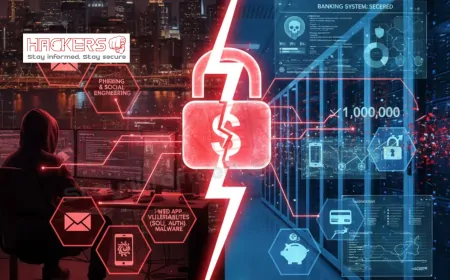What Cybersecurity Measures Should Digital Banks Implement in 2025?
Imagine logging into your banking app, only to find your life savings gone. Your personal details are being sold on the dark web, and fraudsters are opening loans in your name. This is not a nightmare. It is a real risk in today’s digital world. As more people shift to digital banks, those that operate entirely online without physical branches, the stakes have never been higher. These banks promise convenience, speed, and lower fees. But with great power comes great responsibility. Cybersecurity is no longer optional. It is the foundation of trust. In 2025, with cyber threats evolving faster than ever, digital banks must stay ahead. This blog explores the essential cybersecurity measures every digital bank should implement to protect customers, data, and their reputation. Whether you are a bank leader, a tech enthusiast, or a regular customer, this guide is written in simple language so everyone can understand what is at stake and what needs to be done.
Table of Contents
- Introduction
- The Rise of Digital Banks in 2025
- The Evolving Cyber Threat Landscape
- Core Cybersecurity Measures for Digital Banks
- Comparison of Security Features in Top Digital Banks
- How to Implement These Measures Effectively
- The Role of Customers in Security
- Conclusion
- Frequently Asked Questions
The Rise of Digital Banks in 2025
Digital banks, also known as neobanks, have exploded in popularity. By 2025, over 300 million people globally use digital-only banking services. In India, platforms like Jupiter, Fi, and Niyo have millions of users. These banks offer instant account opening, zero-balance savings, and seamless UPI payments. There are no branches, no paperwork, and no long queues. Everything happens on your phone.
But this convenience comes with risk. Digital banks store all customer data online. A single breach can expose millions of records. Unlike traditional banks with decades of security experience, many digital banks are startups. They focus on user experience and growth, sometimes at the cost of robust security. In 2025, regulators like the Reserve Bank of India (RBI) and the Monetary Authority of Singapore are pushing stricter rules. Customers are also demanding better protection. Security is now a competitive advantage.
The Evolving Cyber Threat Landscape
Cybercriminals are smarter, faster, and more organized. In 2025, the top threats to digital banks include:
- Phishing attacks using AI-generated emails that look real
- Ransomware that locks bank systems and demands payment
- API vulnerabilities, where hackers exploit connections between apps
- Deepfake voice and video scams to trick customer support
- Supply chain attacks through third-party vendors
- Insider threats from employees or contractors
According to cybersecurity reports, financial institutions face over 300 cyber attacks per week on average. Digital banks, with their fully online model, are prime targets. A successful breach can lead to financial loss, legal penalties, and permanent damage to trust.
Core Cybersecurity Measures for Digital Banks
Here are the must-have security measures every digital bank should implement in 2025. We explain each in simple terms.
- End-to-End Encryption: All data, whether stored or in transit, must be encrypted. This means even if hacked, the data looks like random code to attackers.
- Multi-Factor Authentication (MFA): Passwords alone are not enough. Require a second step, like a fingerprint, face scan, or one-time code sent to the phone.
- Zero Trust Architecture: Never trust any user or device by default. Verify every login, even from known phones or locations.
- AI-Powered Fraud Detection: Use artificial intelligence to monitor transactions in real-time and flag unusual patterns, like a login from another country.
- Regular Penetration Testing: Hire ethical hackers to test the system for weaknesses before real attackers find them.
- Secure APIs: Application Programming Interfaces (APIs) connect the bank app to other services. They must be protected with rate limiting and authentication.
- Employee Training: Teach staff to spot phishing, use secure passwords, and follow data handling rules.
- Incident Response Plan: Have a clear step-by-step plan for what to do during a breach, including customer communication and system recovery.
- Data Minimization: Collect only the data you need. Less data means less risk if breached.
- Biometric Authentication: Use fingerprint, face, or voice recognition for high-value transactions.
These are not optional. They are the minimum standard for survival in 2025.
Comparison of Security Features in Top Digital Banks
Not all digital banks are equal when it comes to security. Here is a comparison of popular platforms in 2025:
| Bank | MFA | End-to-End Encryption | AI Fraud Detection | Biometric Login | Zero Trust |
|---|---|---|---|---|---|
| Jupiter | Yes | Yes | Yes | Yes | Partial |
| Fi Money | Yes | Yes | Yes | No | No |
| Niyo | Yes | Yes | Partial | Yes | No |
| Revolut | Yes | Yes | Yes | Yes | Yes |
| Chime | Yes | Yes | Yes | Yes | Partial |
As the table shows, global leaders like Revolut set the benchmark. Indian digital banks are catching up but still lag in advanced features like zero trust.
How to Implement These Measures Effectively
Knowing what to do is one thing. Doing it well is another. Here is a step-by-step guide:
- Step 1: Conduct a Security Audit - Hire experts to assess current systems and find gaps.
- Step 2: Build a Dedicated Security Team - Include engineers, analysts, and compliance officers.
- Step 3: Choose Reliable Technology Partners - Work with certified cloud providers like AWS or Google Cloud.
- Step 4: Test, Test, Test - Run simulations of cyber attacks monthly.
- Step 5: Train Everyone - From the CEO to customer support, all staff must understand security.
- Step 6: Communicate with Customers - Be transparent about security practices to build trust.
- Step 7: Stay Updated - Cyber threats change daily. Subscribe to threat intelligence feeds.
Implementation is not a one-time task. It is an ongoing commitment.
The Role of Customers in Security
Banks cannot do it alone. Customers play a key role:
- Use strong, unique passwords
- Enable MFA everywhere
- Avoid clicking suspicious links
- Update apps regularly
- Report unusual activity immediately
- Never share OTPs or login details
Digital banks should make security easy. For example, send reminders to enable MFA or offer password managers.
Conclusion
In 2025, digital banks are the future of finance. But with great innovation comes great risk. Cybersecurity is not a cost. It is an investment in customer trust and business survival. Every digital bank must implement end-to-end encryption, multi-factor authentication, AI fraud detection, zero trust, and regular testing. They must train staff, secure APIs, and educate customers. The threat landscape is ruthless, but the tools to fight back are available. Banks that prioritize security will thrive. Those that don’t will fade away. The choice is clear: protect your customers, or lose them forever. The time to act is now.
Frequently Asked Questions
What is a digital bank?
A digital bank operates entirely online without physical branches. Customers manage accounts through apps or websites.
Why do digital banks need strong cybersecurity?
They store all data online and handle sensitive financial information, making them prime targets for hackers.
What is multi-factor authentication?
It requires two or more verification steps, like a password and a fingerprint, to log in.
Can AI really stop fraud in banks?
Yes, AI analyzes patterns and detects unusual activity in real-time, much faster than humans.
What is zero trust in banking?
It means never trusting any user or device by default. Every access request is verified.
Are digital banks safer than traditional banks?
Not automatically. Safety depends on the security measures they implement.
How often should banks test their security?
At least quarterly, with monthly simulations for high-risk systems.
What is end-to-end encryption?
It protects data from the moment it leaves your phone until it reaches the bank server.
Can customers be hacked even if the bank is secure?
Yes, through phishing or weak passwords. Customer awareness is crucial.
What should I do if I suspect a breach?
Contact the bank immediately, change passwords, and monitor your account.
Do all digital banks use biometric login?
No, but leading ones offer fingerprint or face recognition for added security.
What is an API in banking?
An API is a connection that lets the bank app talk to other services, like payment gateways.
Why do hackers use phishing?
It is cheap, easy, and tricks people into giving away login details willingly.
Can ransomware affect digital banks?
Yes, it can lock critical systems and demand payment to restore access.
What is penetration testing?
It is when ethical hackers try to break into the system to find weaknesses.
Should digital banks share security details with customers?
Yes, transparency builds trust. Share high-level practices without revealing sensitive info.
Is cloud storage safe for bank data?
Yes, if using certified providers with strong encryption and access controls.
What is the biggest cybersecurity risk in 2025?
AI-powered social engineering, like deepfake videos used to trick staff or customers.
Can small digital banks afford strong security?
Yes, many tools are available as affordable subscriptions, like cloud security services.
Will cybersecurity measures slow down the banking app?
Modern security is designed to be fast. Good implementation should not affect user experience.
What's Your Reaction?

















































![Most Dangerous Hacker In The World [2024]](https://www.hackers4u.com/uploads/images/202409/image_430x256_66daf50283149.webp)





